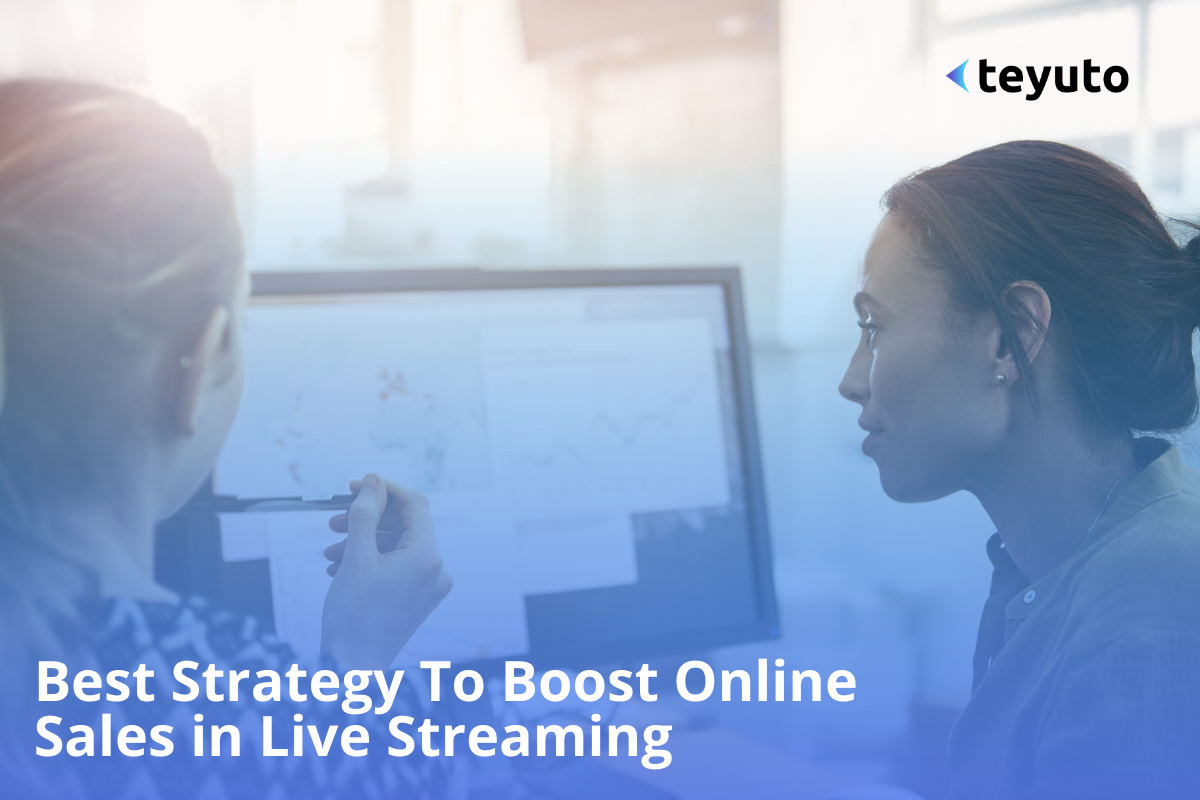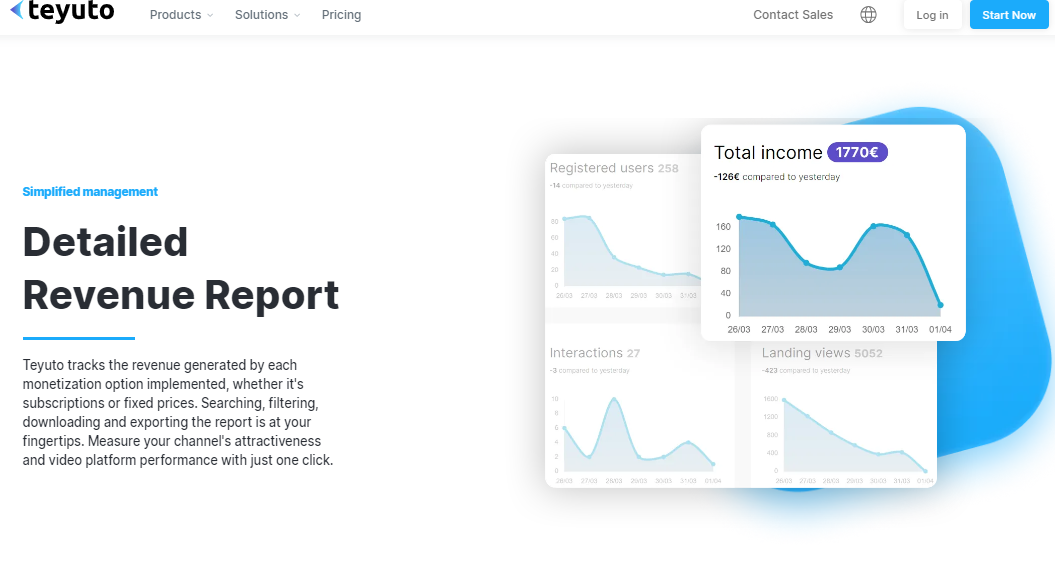

Ever wondered how to use a video to increase sales? Nowadays, most people have watched or participated in live-streaming sessions, especially as video streaming has become a dominant marketing strategy for businesses and individuals. And, they’ve got a name for it. It’s called “Live Commerce.”
According to Coresight Research, global live commerce sales will reach $171 billion USD in 2023.
Brands, both big and small, are testing a new online sales tool - cloud video streaming. This format became intensely popular during the pandemic and hasn’t lost its sheen ever since. It allows the brand not only to increase profits but also to make the audience more loyal. But how should you go about it? Let’s get into the tiny details.
Strategies To Boost Online Sales in Live Streaming

Here are some practical ways to put live commerce into practice. Let's go!
1. Know your Audience
When you look for a tutorial on the internet, what do you prefer: text or video content? 25% of people, when searching on Google, click on the videos on the first page to learn more quickly.
This is a fundamental point for any marketing and sales strategy you are planning. Therefore, we put it as the first step.

But when we talk about boosting sales in live streaming, knowing your audience goes beyond knowing whether they are in the habit of buying online or not. It is necessary to understand the content consumption patterns, times when your audience usually buys, and which types of influencers it most identifies with, among other factors.
To get a sense of what the best video streaming strategy will be for your audience, answer the questions below accurately:
- What are your audience's favorite video consumption platforms?
- On what devices do they prefer to watch video content?
- What are the most consumed video formats?
- How willing is your audience to watch videos?
- How will your audience benefit from your videos?
Read Also: Full-Funnel Content Strategy For Video Marketing
Defining your buyer persona, that is, the profile of your ideal customer, is important to fine-tune your entire marketing and sales strategy. By knowing who you want to reach and how these people behave, work, content, and language used in your actions become much more assertive.
The best tools to evaluate buyers’ persona are:
Google Analytics

Google Analytics is one of the best tools to track the performance of your website. You can track visitors' location, the average spent time, and content preference.
Facebook Pixel
Facebook Pixel helps you to monitor user activity, including pages they visit, which products they view, and whether they make a purchase. You can also use the Facebook Pixel to monitor the performance of Facebook ads which will ultimately help you in evaluating your marketing campaigns.
Google News Initiative
Although GNI is a journalist training and funding tool, it can help you in finding the accurate and most reliable latest information about any product or service in a specific country.

2. Search for influencers
Live streaming channels are like a unique form of entertainment. Thus, relevant content and a dose of charisma are essential to reach good levels of engagement. Here, searching for a relevant influencer can make all the difference.

But calm down! When we use the word influencer, we are not exclusively referring to that person with millions of followers. Taking into account your audience and segment, a micro or even a nano-influencer can make a lot of sense for the strategy.
The important thing, in these cases, is to choose a type of influencer that is connected to your buyer persona's habits and values.
3. Plan Promotions
To attract more people, take advantage of the broadcast to offer discounts, promotions, and special conditions for those who are watching live and make the purchase right there.
The use of mental triggers, such as urgency and scarcity, is already a well-known and important sales technique for retail. In the case of live-streaming, they can make even more sense and positively impact your conversion rate.
4. Prepare an Engaging Script
A famous American writer; Harvey Diamond says, “If you don't know what you want to accomplish with your presentation, neither will your audience.” Having a script ready doesn't hurt anyone, right?
Therefore, an essential step before doing live streaming is to structure an assertive script, listing:
- Major Products/Services
- Main Features
- Pain Points of Audience to Interact
This step will give you more organization and peace of mind if something unforeseen happens.
5. Measuring and Analyzing Results
Alright, we already know the importance and some benefits of measuring the results. But what are the most important elements to start doing this work?
In order to measure video streaming results, there are some essential points:
- Define the most important metrics
- Calculate conversion rates between steps
- Identify the company's objectives
- Knowing the tools to put the strategies into practice
- Generate the reports to make the correct analyses
The data will tell you about the habits and interests of the audience. Analytics will tell you which content resonates with the audience and which strategy was not very successful.
Data-driven decision-making is the best way to unlock the full potential of your advertising and business.
Key Marketing Metrics

There are several metrics that will help to deepen your analysis. In video marketing, some of the most used are:
- Number of visitors
In marketing analytics, the number of visitors means measuring the total number of unique people who visit a particular website or app over time. It helps individuals and companies track the reach of their marketing campaigns.
- Number of leads
In marketing metrics, leads are referred to the number of buyers/subscribers who have shown interest in your product or service. Website forms, landing pages, and email signup forms obtain this data.
- MQL
MQL stands for "Marketing Qualified Lead". It's a lead that has a higher chance of becoming a customer than other leads. MQLs are usually qualified based on things like interest in the product or service, and how big their business is.
- SAL
SAL stands for Sales Accepted Lead. It is a Marketing Qualified Lead that has a good sales indication lead from your sales team. In marketing strategies, we choose SALs based on their budget, decision-making capability, and their potential to buy your product/ service.
- ROI
ROI means return on Investment. It determines the profit generated by investment in particular marketing campaigns. ROI is further divided into four most common metrics including:
- Cost per Lead
- Cost Per Acquisition
- Return on Ad Spend
- Customer Lifetime Value
Metrics and conversion rates can already show a way to measure your results. But to know which ones are most relevant to your operation, you also need to define what the core objectives of the business are.
- Where does the company hope to go?
- With current efforts, what can we expect from the results?
Also read: 5 Steps to Sell Video Online: A Tutorial for Beginners
All efforts generated in marketing and sales will be measured according to these objectives and goals. These answers will indicate what are the priorities in customer acquisition.
Find Sponsors
You can promote videos using affiliate links or sponsors. Sponsorship is common in podcasts, radio shows, and other types of content. Why not try this strategy live as well?
For example, Lewis House, like many other podcasters and content creators, mentions his sponsors at the beginning and end of each episode. Viewers are loyal to this because they know that this is how the person whose opinion they listen to earns his money. Your audience probably won't mind either.

Remember that you must name your affiliate links and other sponsored content. Tell your audience that you want to take a moment to talk about your sponsors.
Choosing the Right Video Streaming Platform
One of the first things businesses need to do when starting live streaming is to invest in the right technology. It also includes investments in live-streaming platforms like Teyuto where you can enjoy low-latency live streaming, live chat and on-screen CTAs along with a free package to start your personal live-streaming channel. In addition, companies must also ensure that they have the necessary equipment such as cameras, microphones, and video editing software.

Businesses can use live streaming to connect with customers, foster relationships, and increase sales. Teyuto is a leading video distribution platform that provides a vast array of features and benefits that can aid the success of businesses of any size.
Here are prominent features of Teyuto that will help you to scale up your business:
Video Analytics:

Teyuto helps its users to track the performance of their content. For instance, it generates detailed reports which include several powerful features including:
- Detailed reports on daily sessions
- Top-performing videos
- Traffic sources
- Audience demographics
- Revenue reports
- Geo-Blocking
Monetization Models:

Teyuto provides a variety of monetization options that can be utilized to generate revenue from live streams. These monetization models consist of subscriptions, Hybrid, and advertising.
Wider Reach:
Teyuto can assist businesses in reaching a global audience of prospective clients. Businesses can live stream to any device, in any country, and in any language using Teyuto.
Reliable & Scalable:
Teyuto is a scalable live-streaming platform that can manage even the most demanding events. This means you can be confident that your live streams will run smoothly, even if you have a large audience.
Conclusion
Live streaming sales are an effective tool to increase revenue for a business if done properly. By identifying the right customers, and carefully preparing and conducting professional sales live streams, businesses will attract many potential customers and increase revenue significantly.


Enjoyed this read?